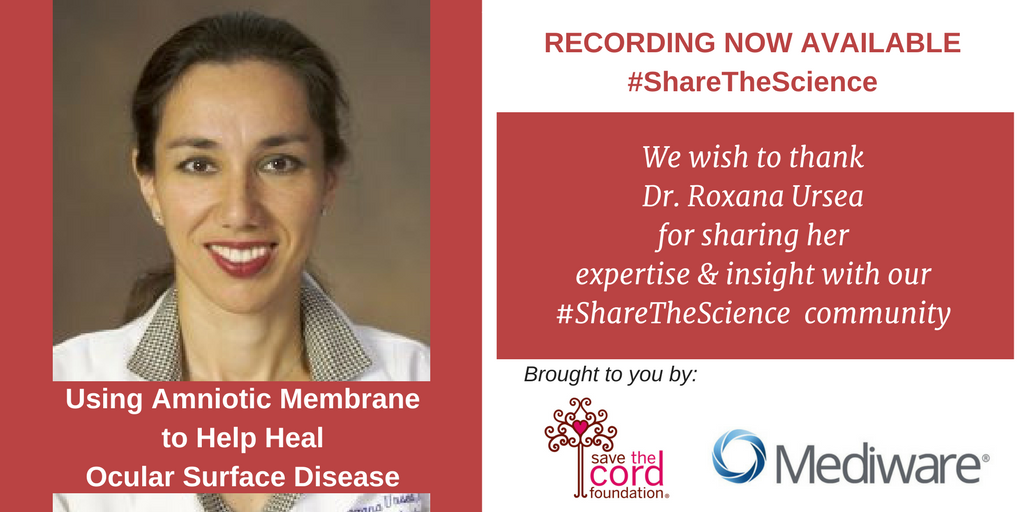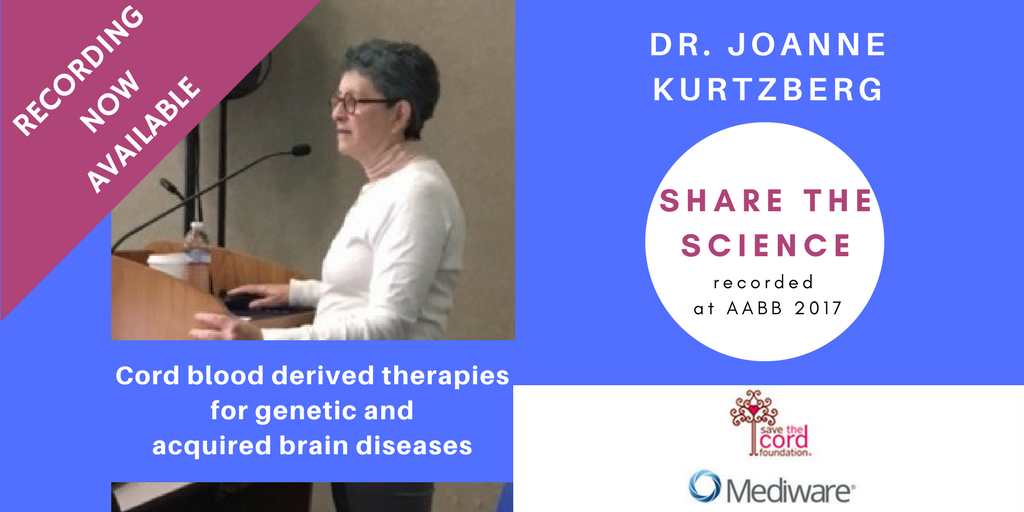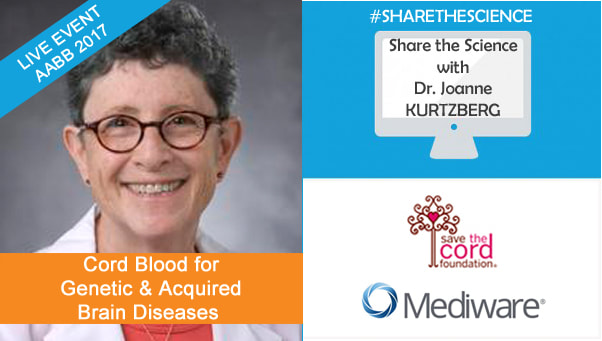Share the Science: Using Amniotic Membrane in Ocular Surface Disease with Dr. Roxana URSEA10/19/2017
UPDATE: RECORDING NOW AVAILABLE, CLICK LINK BELOW — On October 24th, 2017, Save the Cord Foundation and Mediware, Inc. will welcome Dr. Roxana URSEA from the University of Arizona Department of Ophthalmology and Visual Sciences. Dr. Ursea will discuss how the amniotic membrane is currently used and how it can help heal ocular surface disease (OSD). She will discuss its clinical significance, her own research in this area and data from various clinical applications. As our readers know well, our primary focus here at Save the Cord Foundation is to encourage the preservation of cord blood stem cells which can be used to treat 80+ diseases. Yet, we also recognize the growing importance of perinatal stem cells, cord tissues, uses for the placenta, amniotic membrane, etc. Scientists agree we are just on the tip of the iceberg in understanding how to use these “by-products” of the birthing process more wisely. We should not simply throw them away without asking first. . . do they have a potential second use? With this thought in mind, Save the Cord Foundation and Mediware, Inc. are proud to announce the next edition in our Share the Science series — a real world example of how the amniotic membrane (a by-product of the birthing process) is currently used in ophthalmology and as well as potential uses for this medical resource in the near future. According to the Bascom Palmer Eye Institute at the University of Miami, ocular surface diseases affect the “surface of the cornea—the transparent layer that forms the front of the eye. These diseases include dry eye syndrome, meibomian gland dysfunctionblepharitis, rosaceous, allergies, scarring from glaucoma medications, chemical burns, thermal burns, and immunological conditions such as Mucous Membrane Pemphigoid and Sjogren’s Syndrome. Ocular surface diseases can severely affect eyesight and quality of life. Symptoms may include blurry vision, discomfort or pain, redness and itching, and in severe cases, blindness due to corneal scarring.” (source: Bascom Palmer Eye Institute – OSD overview ). Use of amniotic membrane for the eye has been common practice for several years and indications for its use have continued to expand. The reasons for its use are numerous. Notably, amniotic membrane, the innermost layer of the placenta, can stabilize the ocular surface. It exhibits strong anti-inflammatory properties, promotes healing without scarring, and supports stem cell expansion. In patients with moderate to severe dry eye, cryo-preserved amniotic membrane plays a role in corneal nerve regeneration and restores corneal nerve integrity. During this webinar, Dr. Ursea will discuss the important role the amniotic membrane plays in healing a variety of ocular surface diseases. She will share data for how to best utilize these clinical applications. She will discuss in detail how the amniotic membrane can be used as a biological bandage for superficial epithelial defects or as a permanent graft for deeper defects, including stromal defects, post-infectious ulcers, recurrent erosions/endothelial basement membrane dystrophy, small corneal perforations, inflammatory conditions, and chemical burns. She will also cover how it is especially beneficial in ocular surface reconstruction cases as well as in selected post-surgical procedures. Please join us for this exciting free webinar. . . Share the Science featuring Dr. Roxana Ursea “Clinical Applications of Amniotic Membrane in Ocular Surface Disease” Tuesday, October 24th | 2 p.m. – 3 p.m. Central Time Free online webinar – Open to the Public RECORDING NOW AVAILABLE – REGISTER ONLINE HERE Attendees will learn about the:
About Dr. Roxana Ursea: Dr. Ursea is a clinical associate professor of ophthalmology at the University of Arizona Department of Ophthalmology and Visual Sciences. After completing her residency in ophthalmology at New York-Presbyterian Hospital/Weill Cornell and University of Maryland in Baltimore, Dr. Ursea expanded her clinical expertise with specialized training in uveitis and ocular immunology at the National Eye Institute of NIH in Bethesda, Maryland. She completed a second fellowship in cornea, external diseases, and refractive surgery at the University of California in San Diego. Dr. Ursea is active in many professional organizations and has published in major peer-reviewed journals. She is a recognized national and international expert in ocular imaging, in particular, high-frequency ultrasound, and has received numerous awards, including the American Academy of Ophthalmology’s Achievement Award and the University of Arizona’s prestigious Vernon and Virginia Furrow Award for Excellence in Teaching Clinical Sciences. Her clinical interests include keratoconus, laser vision correction, and challenging uveitis cases while her research interests include exploring new applications of high frequency ultrasound and new therapeutic modalities for anterior segment disorders. She has an active clinical and surgical practice at Northwest Medical Center in Tucson, Arizona. Save the Cord Foundation wishes to thank Dr. Ursea for sharing her valuable insight and expertise with our Share the Science community. We also wish to thank Mediware, Inc. for their continued generous support of this program. Share the Science continues to be a popular series within the cord blood community and beyond. We welcome your input on the series and suggestions for future speakers. Give your feedback here.
Previous Share the Science presentations have been archived for your reference. Discover the work of leading scientists and cord blood industry experts through this educational series. View the archive now. Share the Science is made possible thanks to the generous support of Mediware, Inc. Share the Science LIVE with Dr. Joanne Kurtzberg: Cord Blood for Autism, Cerebral Palsy and more10/18/2017
Update: RECORDING NOW AVAILABLE. This presentation was made live on October 9th, 2017 during the AABB 2017 Annual Meetings. To view the recording, simply follow the link below. Dr. Joanne Kurtzberg is recognized around the world for her outstanding work in cord blood research. In recent years, her research has been focused on using cord blood to potentially treat autism in young children. As the results from her clinical trials have started to come in, the medical world and parents have taken notice. She was recently interviewed by CNN along with her colleague, Dr. Geraldine Dawson, Director of Duke’s Center for Autism and Brain Development, about the encouraging results from these clinical trials. With more than two-thirds of children showing improvement, Dr. Kurtzberg and her team are now moving into phase two hoping to find a long-term treatment option for children with autism. According to Dr. Kurtzberg, cord blood cells can work through paracrine and trophic mechanisms to help endogenous cells heal brain tissue damaged by disease or injury. Learning from observations made using unrelated donor umbilical cord blood transplant after myeloablative chemotherapy to treat children with certain inherited metabolic diseases, cord blood therapies have been developed to treat children with acquired brain injuries, like hypoxic ischemic encephalopathy, cerebral palsy, and autism. As the research moves forward and new clinical trials begin, Dr. Kurtzberg has agreed to speak with our Share the Science community about the safety and feasibility of using autologous cord blood infusion in young children with autism spectrum disorder. She will also expand her talk into other areas of possible clinical application for cord blood therapies. Join us for this exclusive live event at the AABB Annual Meetings in San Diego, California.
Data from early phase human clinical trials for safety and efficacy in these diseases will be presented by Dr. Kurtzberg. Results of preclinical and IND-enabling studies will be presented to provide information about safety and potential mechanisms of action of cord blood cells in this setting. In addition, attendees will learn about:
About the speaker Joanne Kurtzberg, MD is the Director, Pediatric Blood and Marrow Transplant Program, Chief Scientific and Medical Officer, Robertson Clinical and Translational Cell Therapy Program, Director, Carolinas Cord Blood Bank and Co-Director, Stem Cell Laboratory. She is an internationally renowned expert in pediatric hematology/oncology, pediatric blood and marrow transplant, umbilical cord blood banking and transplant, and novel applications of cord blood in the emerging fields of cellular therapies and regenerative medicine. Over the last two decades, Dr. Kurtzberg has established an internationally known pediatric transplant program; one of the largest unrelated donor cord blood banks, the Carolinas Cord Blood Bank, in the world; and the Julian Robertson Cell and Translational Therapy Program (CT2) at Duke. Dr. Kurtzberg has published more than 300 peer-reviewed papers, multiple chapters, and scientific reviews. She is a member of the American Society of Hematology, the American Association of Blood and Marrow Transplantation, the American Society of Pediatric Hematology/Oncology, the International Society of Cellular Therapies, the Pediatric Blood and Marrow Transplant Consortium (PBMTC), and other organizations. She serves on the Board of the Foundation of Accreditation of Cellular Therapies, Advisory Council of Blood Stem Cell Transplantation to Health and Human Services. Dr. Kurtzberg was awarded a Lifetime Achievement Award from the PBMTC in 2012. We wish to thank Dr. Kurtzberg for sharing her valuable insight on cord blood research for autism with our Share the Science community. We also wish to thank Mediware, Inc. for their generous support making this webinar possible. #ShareTheScience Previous Share the Science presentations have been archived for your reference. Discover the work of leading scientists and cord blood industry experts through this educational series. View the archive now.
Share the Science is made possible thanks to the generous support of Mediware, Inc. |
AuthorWrite something about yourself. No need to be fancy, just an overview. Archives
December 2023
Categories |






 RSS Feed
RSS Feed


